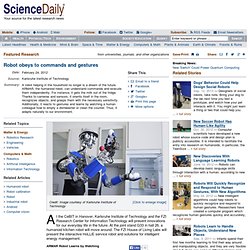

Passive Walking Robot Propelled By Its Own Weight #DigInfo. RB3D develops Hercule robotic exoskeleton, boosts strength without P90X. PR2 Teleoperation Using Kinect. Homme augmenté mode d’emploi. Si vous n'y connaissez pas grand chose au sujet, voici une première approche faisant le point sur la recherche dans le domaine et les enjeux éthiques et économiques.

Les 2 et 3 avril (2010, ndlr), Megève accueille le premier Congrès International de l’Homme Augmenté. Une réunion de scientifiques, commerciaux, chercheurs et penseurs autour du thème de cet homme nouveau, qui utilise la technologie pour maximiser ses possibilités. Comme souvent lorsque l’on aborde le sujet des biotechnologies, il s’agira d’examiner les bénéfices qui peuvent être tirés (humains et économiques), mais aussi de soulever les questions éthiques, légales et de sûreté. L’homme 2.0, le Bioman de notre enfance, n’est plus confiné aux romans ou aux films de science-fiction futuristes, il a déjà un pied bien ancré dans notre monde. Membres ressuscités Cela fait plusieurs années que des prothèses ingénieuses voient le jour. Exosquelette Qu’est ce que c’est que ce nom barbare ? Remue-méninges Éthique en toc ? Lexique à brac. Robot obeys to commands and gestures. At the CeBIT in Hanover, Karlsruhe Institute of Technology and the FZI Research Center for Information Technology will present innovations for our everyday life in the future.

At the joint stand G33 in hall 26, a humanoid kitchen robot will move around. The FZI House of Living Labs will present the interactive HoLLiE service robot and solutions for intelligent energy management. ARMAR Robot Learns by Watching A robot helping in the household no longer is a dream of the future. ARMAR, the humanoid robot, can understand commands and execute them independently. Thus, it adapts naturally to our environment. A video on ARMAR can be found at: Indoor navigation system for blind. University of Nevada, Reno computer science engineering team Kostas Bekris and Eelke Folmer presented their indoor navigation system for people with visual impairments at two national conferences in the past two weeks.

The researchers explained how a combination of human-computer interaction and motion-planning research was used to build a low-cost accessible navigation system, called Navatar, which can run on a standard smartphone. "Existing indoor navigation systems typically require the use of expensive and heavy sensors, or equipping rooms and hallways with radio-frequency tags that can be detected by a handheld reader and which are used to determine the user's location," Bekris, of the College of Engineering's Robotics Research Lab, said. "This has often made the implementation of such systems prohibitively expensive, with few systems having been deployed.
" "My research is motivated by the belief that a disability can be turned into an innovation driver," Folmer said. Paralyzed individuals use thought-controlled robotic arm to reach and grasp. N an ongoing clinical trial, a paralyzed woman was able to reach for and sip from a drink on her own -- for the first time in nearly 15 years -- by using her thoughts to direct a robotic arm.

The trial, funded in part by the National Institutes of Health, is evaluating the safety and feasibility of an investigational device called the BrainGate neural interface system. This is a type of brain-computer interface (BCI) intended to put robotics and other assistive technology under the brain's control. A report published May 16 in Nature describes how two individuals -- both paralyzed by stroke -- learned to use the BrainGate system to make reach-and-grasp movements with a robotic arm, as part of the BrainGate2 clinical trial.
The report highlights the potential for long-term use and durability of the BrainGate system, part of which is implanted in the brain to capture the signals underlying intentional movement. "The smile on her face was a remarkable thing to see. Dr. Dr. Exoskeleton of advanced design promises new degree of independence for people with paraplegia. The dream of regaining the ability to stand up and walk has come closer to reality for people paralyzed below the waist who thought they would never take another step.

A team of engineers at Vanderbilt University's Center for Intelligent Mechatronics has developed a powered exoskeleton that enables people with severe spinal cord injuries to stand, walk, sit and climb stairs. Its light weight, compact size and modular design promise to provide users with an unprecedented degree of independence. The university has several patents pending on the design and Parker Hannifin Corporation -- a global leader in motion and control technologies -- has signed an exclusive licensing agreement to develop a commercial version of the device, which it plans on introducing in 2014. According to the National Spinal Cord Injury Statistical Center, somewhere between 236,000 to 327,000 people in the U.S. are living with serious spinal cord injuries. About 155,000 have paraplegia.